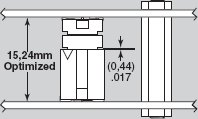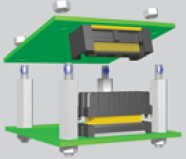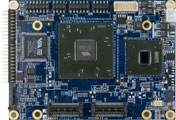Via spins first SUMIT expansion module
Mar 30, 2009 — by Eric Brown — from the LinuxDevices Archive — views Via Technologies has announced its first expansion module using a SUMIT (Stackable Unified Module Interconnect Technology) interface. Designed primarily for the company's Epia-P710 Pico-ITXe board, the “Epia-P710-HD” adds an S3 4300E embedded graphics processor, providing HD video playback capability and multiple… display support, the company says.
Via Technologies has announced its first expansion module using a SUMIT (Stackable Unified Module Interconnect Technology) interface. Designed primarily for the company's Epia-P710 Pico-ITXe board, the “Epia-P710-HD” adds an S3 4300E embedded graphics processor, providing HD video playback capability and multiple… display support, the company says.
(Click for a larger view of Via's Epia-P710-HD module)
Via, the creator of the 3.9 x 2.8-inch pico-ITX motherboard format, transferred ownership of the spec to the Small Form-Factor Special Interest Group (SFF-SIG) last year, and later unveiled pico-ITXe, a version that adds the SFF-SIG's SUMIT interface. Instead of using pins that pass all the way through the board, like PC/104, SUMIT, pictured below, uses a pair of one-sided, surface-mount QMS/QFS (quiet male “635”/quiet female “635”) connectors with 52 pins each. Boards (typically I/O boards) that need pass-through do so with “vias” in the printed circuit board. Each connector is tiny, measuring less than an inch long, and optimized for a stand-off height of just a sixth of an inch (15.24mm).


The SUMIT physical interface
(Source: Samtec)
 Epia-P710 |
Announced last October, the Via Epia-P710, pictured at right, was the company's first pico-ITXe board. It includes a 1GHz Via C7 processor, up to 2GB of DDR2 memory, and supports Linux, Windows CE, and Windows XP/XPe. According to Via, the board is equipped with one IDE channel, dual SATA channels, and pin headers are said to provide access to gigabit Ethernet, VGA, LVDS, audio, and front panel LEDs. The Epia_P710's two SUMIT connectors integrate LPC, SPI, SMBus, and three USB 2.0 interfaces, according to Via.
The Epia-P710-HD module
The Epia-P710 already offers the Via VX800 media system processor, featuring Via Chrome9 graphics, but with the HD module, it now offers the S3 Graphics 4300E embedded graphics processor for 1080P HD playback and dual DVI and HDMI displays, says Via. The module is aimed at “sophisticated” digital signage, arcade gaming, kiosk, and POI applications, says the company. Because of its standard SUMIT connectors, the module may also work with other Pico-ITXe boards, though Via made no claims to this regard.
The S3 Graphics 4300E chip boasts a total graphics subsystem TDP of less than eight watts, says the company. The 4300E is said to offer a programmable video core, Blu-ray Disk compatibility, and codec support including WMV9 HD, MPEG-2 HD, VC-1, H.264, and AVS. It is also compliant with DirectX 10.1 and OpenGL 2.1, supporting dual DVI, HDMI, S-Video, and LVDS transmitters across PCIe 2.0. The HDTV encoder is said to support all eighteen DTV ATSC and DVB standards, including 1080p.
The Via P710-HD module includes 256MB of dedicated GDDR 2, supporting separately configurable dual DVI, HDMI, and S-Video ports at resolutions up to 2560 x 1600, Via says. Dual-channel LVDS and an analog VGA header are also said to be available.
Stated Daniel Wu, VP of Via Embedded, Via Technologies, “The VIA P710-HD module, when paired with a Pico-ITXe board, opens up a new world of digital brilliance.”
Availability
Via did not list pricing or availability information on the Via P710-HD module, but will show the board at this week's Embedded Systems Conference (ESC) in San Jose. More information on Via's ESC plans may be found here, and more on the module and the Epia-P710 (which is shipping now at an undisclosed price), may be found here.
This article was originally published on LinuxDevices.com and has been donated to the open source community by QuinStreet Inc. Please visit LinuxToday.com for up-to-date news and articles about Linux and open source.